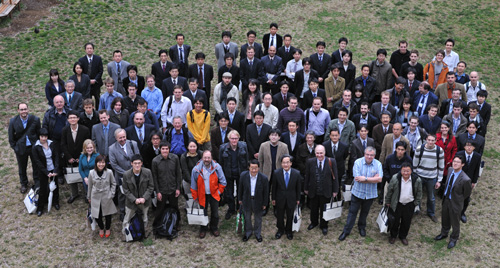
Date: April 7 - April 11, 2008
Venue: Convention Hall (2nd floor)in Building A, North (An)
Komaba Research Campus, the University of Tokyo, Tokyo, Japan
[
Campus map /
Access map ]
Sponsored by
Institute for Nano Quantum Information Electronics, the University of Tokyo
[
web site]
Co-sponsored by
Secure-Life Electronics, Global COE, The University of Tokyo
and
Optoelectronic Industry and Technology Development Association (OITDA)

High resolution photograph : [
Photo1 /
Photo2 ]
 Important Dates
Important Dates |
|
February 1, 2008: Deadline for abstract submission
February 29, 2008: Deadline for early registration
March 5, 2008: Deadline for accommodation application
March 31, 2008: Deadline for on-line registration*
*After April 1, 2008, only on-site registration is available. Please register on-site at conference venue.
* PLMCN17 webpage is open! |
http://www.plmcn8.iis.u-tokyo.ac.jp/
e-mail:plmcn8[at]iis.u-tokyo.ac.jp
(Please use the mail address replacing [at] with @.)
Last updated May 13, 2015
Conference scope
This conference will be devoted to the fundamental and technological
issues relevant to the realization of a new generation of opto-electronic
devices based on advanced low-dimensional and photonic structures, such as
low threshold polariton lasers, new optical switches, single photon
emitters, photonic band-gap structures, etc. It should review recent
achievements in the fundamental understanding of strong light-matter
coupling, as well as follow progress in the development of epitaxial and
processing technologies of wide gap semiconductor and organic
nanostructures and microcavities providing the basis for advanced optical
studies. The conference will be open to new emerging field as carbon
nanotubes and quantum information.
The idea of this conference is to bring together scientists active in
the fields of semiconductor optics and material science dealing with modern
technologies of wide-band semiconductor and organic materials, both in
academia and industry. This combination should be very fruitful in
preparation for future breakthroughs in these areas of physics.
The scope of the Conference covers both physics and application of a
variety of phenomena related to light-matter coupling in solids.
Topics to be discussed include, but are not limited to:
Light-matter coupling in microcavities and photonic crystals
Basic exciton-polariton physics
Bose-condensation
Spin related phenomena
Physics and application of quantum dots
Plasmons and near-field optics in light matter coupling
Growth and characterization of advanced wide-gap nanostructures (GaN,
ZnSe, ZnO, organic materials)
Novel optical devices (polariton lasers, single-photon emitters, entangled
photon pair generators, optical switches...)
Quantum information and processing


